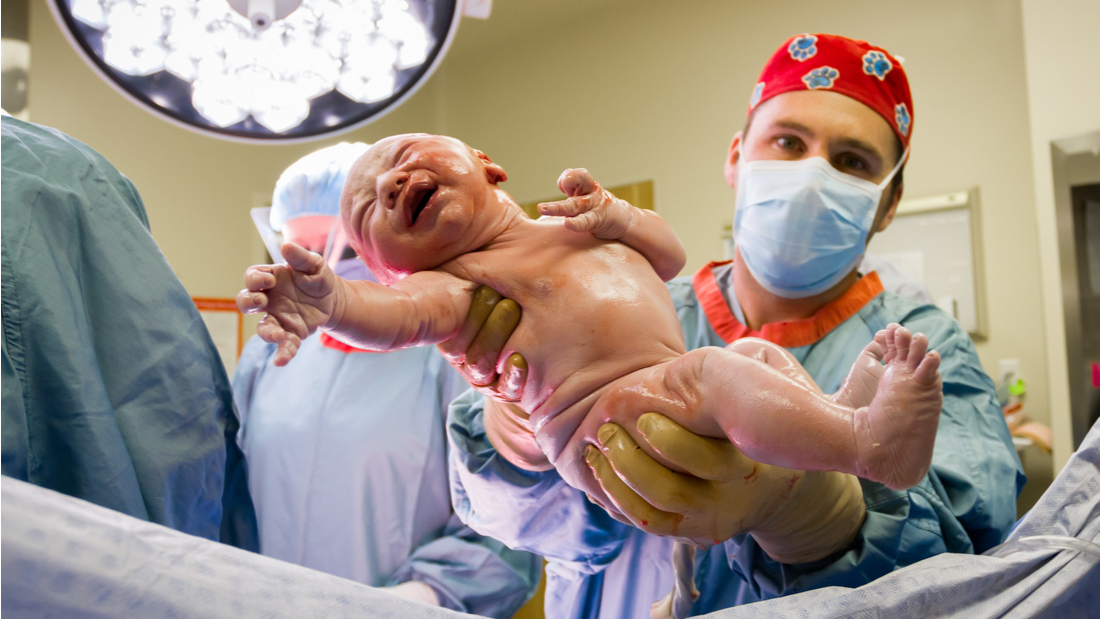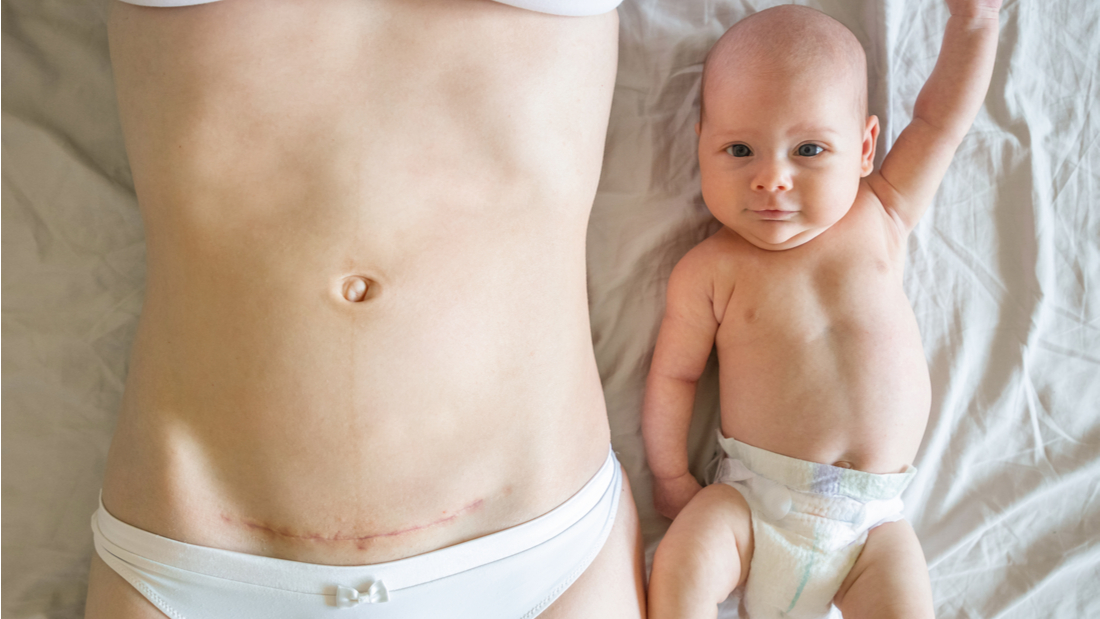What to Expect After a Caesarean Section
In this article:
- From recovery room to home
- What will happen when I leave the operating theatre?
- When will I be able to hold and feed my baby?
- Will I be able to breastfeed following a caesarean section?
- Will I be in pain following a C-section?
- How long will I need to stay in hospital?
- How to care for the scar
- When will the stitches be removed?
- How long will the scar take to heal?
- Sex after a C-section
- Most common medications following discharge
- When to get medical advice following a C-section
- Main points

From recovery room to home
A caesarean section, C-section or CS, is the most commonly performed operation across the world and approximately 1 in 4 pregnant women in the UK will give birth by C-section. But what happens after a C-section?
What will happen when I leave the operating theatre?
In most units, after having the C-section you will be taken to the recovery area where the midwives and the anaesthetist (the doctor responsible for providing pain relief during the operation) will be able to monitor you more closely.
The effects of the anaesthesia take some time to wear off; it will be a few hours before you are able to fully feel and move your legs again if you have had a spinal anaesthesia. During this time, you are only expected to rest and spend time with your baby. Once the effects wear off, you will be encouraged to eat and drink a little, but you may feel a little nauseous. Expect to spend 2-6 hours in the recovery unit depending on the type of anaesthesia you had and how well you feel. If after a few hours both you and baby are well, you will be transferred to the postnatal ward.
Your birthing partner will be allowed in the recovery room with you but unfortunately visitors are not allowed into this area. Usually visiting happens on the postnatal ward.
When will I be able to hold and feed my baby?
You can request to see the baby immediately following delivery in the theatre. You won’t be able to see the operation and will not be allowed to touch your baby at this point as the surgical area is sterile. Once your baby is born, it is dried with warm towels and its breathing is checked either by a neonatal doctor or the midwife. After a few minutes, the baby will be given to your partner. If you feel well enough, the baby can be placed onto your chest with the support of the midwife and your partner.
Once the procedure is finished and the baby is well, you will be able to sit up more comfortably and hold the baby for skin-to-skin contact. The midwife can assist you further if you would like to feed the baby. Usually you will hold the baby on your chest as you are moved from the theatre to the recovery room. For most mothers, the first time they breastfeed is in the recovery room.
Will I be able to breastfeed following a caesarean section?
Yes, the actual procedure does not cause any problem with the expression of the milk. However, you might find it harder to establish breastfeeding after the caesarean section, for instance if you have pain or difficulty moving around due to the drip in your arm.
Will I be in pain following a C-section?
Having a C-section is a major operation and whilst you may feel some discomfort, you should not be in any significant pain.
Immediately following the C-section and as the anaesthesia wears off, you will be given a combination of pain relief tablets (ibuprofen, paracetamol) to ensure that you remain comfortable. These are safe if you are breastfeeding. If you are ever in pain, there is more analgesia available to deal with this. The nurses and midwives in the recovery unit are very experienced at looking after women following C-sections.
In the next few days, you may feel sore and bruised especially around the area of the wound. The pain can peak in the first 1-2 days and then it should improve. Therefore, it is important to be proactive and take regular painkillers to keep on top of the pain initially. You should be able to walk around, carry and feed the baby without too much discomfort.
How long will I need to stay in hospital?
The average stay in a hospital after having a C-section is 2-4 days. If you are having an elective caesarean, you may be offered an enhanced recovery where you can be discharged after 24 hours. If this is your first baby, you may feel more comfortable staying an extra day. The time at which you are discharged will also depend on any other complications during your pregnancy, for example, women with preeclampsia may need to stay in the hospital for up to five days postnatally. Discharge also depends on whether the baby is doing well.


How to care for the scar
You will have a wound dressing (a large plaster) over the scar. Nowadays, most of the dressings used are waterproof so that you can shower with them. It is a common practice to remove the dressing in the hospital, 24 hours after the CS so the wound can be checked to ensure proper healing. Once this has been done, a new dressing may be applied, usually by the doctor or the midwife. At home, you can remove the dressing as early as 48 hours following the CS. You might find it easier to remove the dressing in the shower because the water can reduce any discomfort. Simple rules of hygiene such as keeping the wound dry and clean, using plain water and no soap for the wound and wearing loose clothes will reduce the risk of infection. Remember to dry the area by patting it with a soft towel after having a shower.
When will the stitches be removed?
Most of the time, absorbable sutures (they dissolve over time) are used but if clips (skin staples) or non-absorbable sutures are used, your midwife will remove these at home, usually 5-7 days after your procedure.
How long will the scar take to heal?
The skin wound will heal within the first 10 days. The layers of the body under the skin will take longer to heal and the actual process can take up to six weeks. Therefore, it is highly advised for you to avoid lifting heavy weights, exercise and driving for the first six weeks following a C-section. However, carrying your baby should be fine.
Sex after a C-section
You can resume sexual intercourse when you and your partner feel ready and comfortable. However, there is a theoretical risk of ovulation after 21 days of delivery. Therefore, it is important to use contraception and you might wish to discuss this further with your midwife or GP. You should avoid getting pregnant for at least one year following the C-section.
Most common medications following discharge
The following are the medications most commonly given to women who have been discharged following a C-section:
- Blood thinner injections to prevent the formation of blood clots: being pregnant puts you at higher risk of developing blood clots in your legs and lungs. Having a caesarean increases this risk further. Blood thinning injections (low molecular weight heparin) can reduce this risk significantly. They are usually first administered in hospital and are continued for 10 days to 6 weeks. They come in the form of a pen, so that you or your partner can do them at home.
- Paracetamol and ibuprofen: it is important to take these regularly for the first few days following a caesarean section.
- Iron tablets if you are anaemic: anaemia, which is caused by low haemoglobin, (the oxygen-carrying component in blood) may happen because of blood loss after delivery. It can leave you feeling tired, faint and breathless. Taking iron will speed up the body’s natural recovery process, so that you can feel better quicker.
When to get medical advice following a C-section
You need to seek medical advice if you have any of the following:
- Severe pain
- Heavy vaginal bleeding or passing clots
- Fevers
- Pain when passing urine
- Your wound becomes red, painful, swollen or is leaking fluid
- A cough or shortness of breath
- Chest pain
- Swelling or pain in your lower leg
Main points
- After your C-section you will be taken to the recovery area where the midwives and the anaesthetist will monitor you closely. You may feel a little nauseous but after a few hours you will be encouraged to eat something and transferred to the postnatal ward.
- Once you can sit up comfortably you can hold the baby for skin-to-skin contact. Most mothers will breastfeed the baby once they are transferred to the recovery room.
- As the anaesthetic wears off, you will be given a combination of pain relief tablets (ibuprofen, paracetamol, weak opioids) to ensure that you remain comfortable..
- The average hospital stay following a CS is 2-4 days. If you are having an elective caesarean, you may be offered an enhanced recovery where you can be discharged after 24 hours.
- Your wound will be covered by a dressing. It is a common practice to remove this in the hospital, 24 hours after the CS so that it can be checked and a new dressing applied. At home, you can remove the dressing as early as 48 hours following the CS.
- Absorbable sutures (they dissolve over time) are used most of the time but if your wound has been stapled with clips or stitched with non-absorbable sutures, your midwife will remove these at home, usually 5-7 days after your procedure.
- You may have sex as soon as you and your partner feel ready and comfortable. Because there is a theoretical risk of ovulation after 21 days of delivery you should use contraception.
- You should avoid getting pregnant for at least one year following the C-section.
- Many women are given blood thinner injections following a caesarean. Paracetamol and ibuprofen are also recommended for the first few days as are iron tablets if you are anaemic.
- You should seek medical advice if you experience severe pain; heavy vaginal bleeding or passing of clots; fever; pain when passing urine; a red, painful, swollen or leaking wound; a cough or shortness of breath; chest pain; swelling or pain in your lower leg.
References:
● https://www.nhs.uk/conditions/caesarean-section/
● https://www.nice.org.uk/guidance/cg132/chapter/1-Guidance#care-of-the-woman-after-cs



